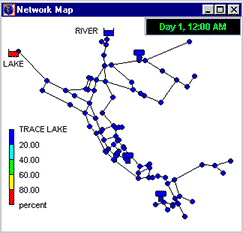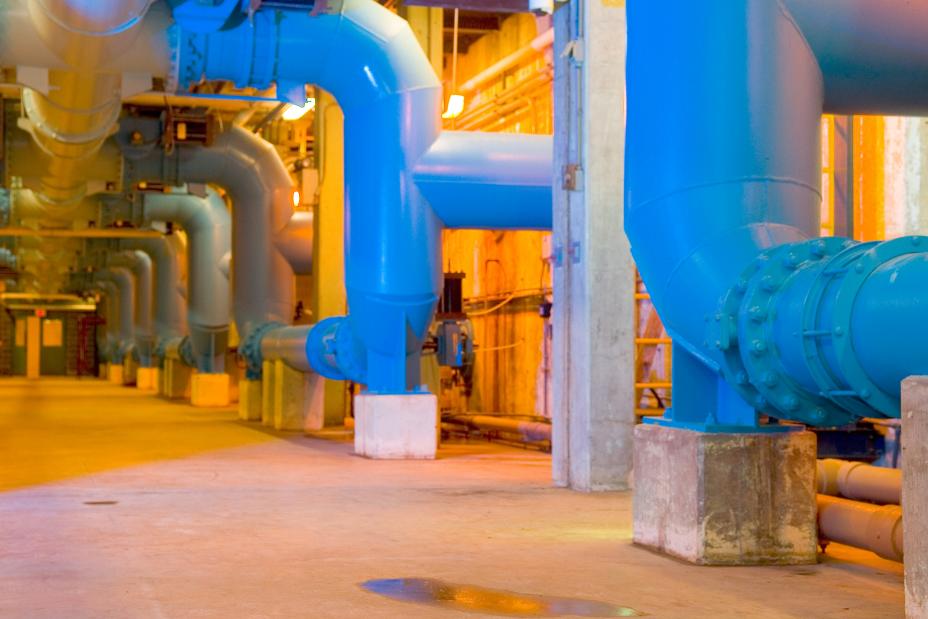EPANET
Application for Modeling Drinking Water Distribution Systems
On this Page
Disclaimer: Any mention of trade names, manufacturers, or products does not imply an endorsement by EPA. EPA and its employees do not endorse commercial products, services, or enterprises.
EPANET is a software application used throughout the world to model water distribution systems. It was developed as a tool for understanding the movement and fate of drinking water constituents within distribution systems, and can be used for many different types of applications in distribution systems analysis. Today, engineers and consultants use EPANET to design and size new water infrastructure, retrofit existing aging infrastructure, optimize operations of tanks and pumps, reduce energy usage, investigate water quality problems, and prepare for emergencies. It can also be used to model contamination threats and evaluate resilience to security threats or natural disasters.
Software, Compatibility, and Manuals
EPANET is public domain software that can be freely copied and distributed. It is a Windows®-based program that will work with all versions of Windows. Continued development and bug fixes are occurring under an open source project site in GitHub. Software bugs and feature requests can be reported on the site as issues, and information is available for those interested in contributing to the code and/or viewing the quality assurance plan, contributor guidelines, software development roadmap, automated testing suite, and other information.
Software
|
Date |
Description |
|---|---|
| 07/23/2020 | Self-Extracting Installation Program for EPANET 2.2 (EXE)Exit(3.5 MB) |
| 07/23/2020 | Non-Installing Software for EPANET 2.2 (ZIP)Exit(2.84 MB) |
| 10/01/2018 | Self-Extracting Installation Program for EPANET 2.00.12 (EXE)(2 MB) |
Toolkit and Extensions
|
Date |
Description |
|---|---|
| 07/23/2020 | EPANET 2.2 Programmer’s Toolkit Files (ZIP)Exit(847 KB) |
| 03/20/2008 | EPANET 2 Programmer’s Toolkit files (ZIP)(253 K) |
| 12/30/2011 | EPANET-MSX (Multi-Species eXtension) |
| 10/01/2015 | EPANET-RTX (Real–Time eXtension) |
Source Codes and Updates
|
Date |
Description |
|---|---|
| 07/23/2020 | EPANET 2.2 Source Code Files (ZIP)Exit(3 MB) |
| 10/01/2018 | EPANET 2 Source Code Files (ZIP)(620 K) |
| 07/23/2020 | EPANET 2.2 Updates (TXT)(3 K) |
| 05/18/2020 | EPANET 2.0 Updates (TXT) |
Manuals
|
Date |
Description |
|---|---|
| 07/23/2020 | EPANET 2.2 Online User's ManualExit |
| 09/11/2000 | EPANET 2.0 User's Manual |
Capabilities
 With EPANET, users can perform extended-period simulation of the hydraulic and water quality behavior within pressurized pipe networks, which consist of pipes, nodes (junctions), pumps, valves, storage tanks, and reservoirs. It can be used to track the flow of water in each pipe, the pressure at each node, the height of the water in each tank, a chemical concentration, the age of the water, and source tracing throughout the network during a simulation period.
With EPANET, users can perform extended-period simulation of the hydraulic and water quality behavior within pressurized pipe networks, which consist of pipes, nodes (junctions), pumps, valves, storage tanks, and reservoirs. It can be used to track the flow of water in each pipe, the pressure at each node, the height of the water in each tank, a chemical concentration, the age of the water, and source tracing throughout the network during a simulation period.
EPANET's user interface provides a visual network editor that simplifies the process of building pipe network models and editing their properties and data. Various data reporting and visualization tools are used to assist in interpreting the results of a network analysis, including color-coded network maps, data tables, energy usage, reaction, calibration, time series graphs, and profile and contour plots.
Hydraulic Modeling
Full-featured and accurate hydraulic modeling is a prerequisite for doing effective water quality modeling. EPANET contains a state-of-the-art hydraulic analysis engine that includes the following capabilities:
- Ability to use pressure dependent demands in hydraulic analyses.
- System operation based on both simple tank level or timer controls and on complex rule-based controls.
- No limit on the size of the network that can be analyzed.
- Computes friction headloss using the Hazen-Williams, Darcy-Weisbach, or Chezy-Manning formulas.
- Includes minor head losses for bends, fittings, etc.
- Models constant or variable speed pumps.
- Computes pumping energy and cost.
- Models various types of valves, including shutoff, check, pressure regulating, and flow control.
- Allows storage tanks to have any shape (i.e., diameter can vary with height).
- Considers multiple demand categories at nodes, each with its own pattern of time variation.
- Models pressure-dependent flow issuing from emitters (sprinkler heads).
- Provides robust results for hydraulic convergence and low/zero flow conditions.
Water Quality Modeling
In addition to hydraulic modeling, EPANET provides the following water quality modeling capabilities:
- Storage tanks as being either complete mix, plug flow, or two-compartment reactors.
- Movement of a non-reactive tracer material through the network over time.
- Movement and fate of a reactive material as it grows or decays with time.
- Age of water throughout a network.
- Percent of flow from a given node reaching all other nodes over time.
- Reactions in the bulk flow and at the pipe wall.
- Accounts for mass transfer limitations when modeling pipe wall reactions.
- Allows growth or decay reactions to proceed up to a limiting concentration.
- Employs global reaction rate coefficients that can be modified on a pipe-by-pipe basis.
- Allows wall reaction rate coefficients to be correlated to pipe roughness.
- Allows for time-varying concentration or mass inputs at any location in the network.
Water Security and Resilience Modeling
Extensions to EPANET are available that work with the existing software to simulate the interactions between multiple chemical and biological agents and their interactions with the bulk water and pipe walls in water distribution systems.
- EPANET-MSX (Multi-Species eXtension) enables EPANET to model complex reactions between multiple chemical and biological species in both the bulk flow and at the pipe wall. This capability has been included into both a stand-alone executable program as well as a toolkit library of functions that programmers can use to build customized applications. EPANET-MSX allows users the flexibility to model a wide-range of chemical reactions of interest, including, auto-decomposition of chloramines to ammonia, the formation of disinfection byproducts, biological regrowth, combined reaction rate constants in multi-source systems, and mass transfer limited oxidation-pipe wall adsorption reactions.
- EPANET-RTX (Real–Time eXtension) provides the methods and software tools by which operational data can be connected with a network infrastructure model, and the resulting network simulation model can be calibrated, verified, and continually tested for accuracy using operational data. EPANET-RTX is software for building real-time hydraulic and water quality models. EPANET-RTX brings real-time analytics to water distribution system modeling, planning, and operations. Analytics refer to the discovery and interpretation of patterns in data. EPANET-RTX software works by providing access accessing available utility data and effectively using it to run a hydraulic and water quality model.
Programmer's Toolkit
This toolkit is a dynamic link library (DLL) of functions that allow developers to customize EPANET to their own needs. The functions can be incorporated into 32-bit Windows applications written in C/C++, Visual Basic, or any other language that can call functions within a Windows DLL. There are over 50 functions that can be used to open a network description file, read and modify various network design and operating parameters, run multiple extended-period simulations accessing results as they are generated or saving them to file, and write selected results to a file in a user-specified format.
The toolkit is useful for developing specialized applications, such as optimization or automated calibration models that require running many network analyses. It can simplify adding analysis capabilities to integrated network-modeling environments based on computer-aided design (CAD), geographical information system (GIS), and database packages. A Windows Help file is available to explain how to use the various toolkit functions. It offers some simple programming examples. The toolkit also includes several different header files, function definition files, and .lib files that simplify the task of interfacing it with code.
Applications
EPANET helps water utilities maintain and improve the quality of water delivered to consumers. It can be used for the following:
- Design sampling programs
- Study disinfectant loss and byproduct formations
- Conduct consumer exposure assessments
- Evaluate alternative strategies for improving water quality
- Modify pumping and tank filling/emptying schedules to reduce water age
- Use booster disinfection stations at key locations to maintain target residuals
- Plan and improve a system's hydraulic performance
- Assist with pipe, pump, and valve placement and sizing
- Energy minimization
- Fire flow analysis
- Vulnerability studies
Related Resources
- EPANET Publications in Science Inventory
- Drinking Water Infrastructure, Treatment, and Security Tools
- Drinking Water Treatment and Analysis Methods
Technical Support
- Questions or comments: Contact us about EPANET

